Pumpless 240mm AiO cooler is only 8C behind traditional pump-powered rival in tests
Prototype from German company Wieland tested by OC expert Der8auer.
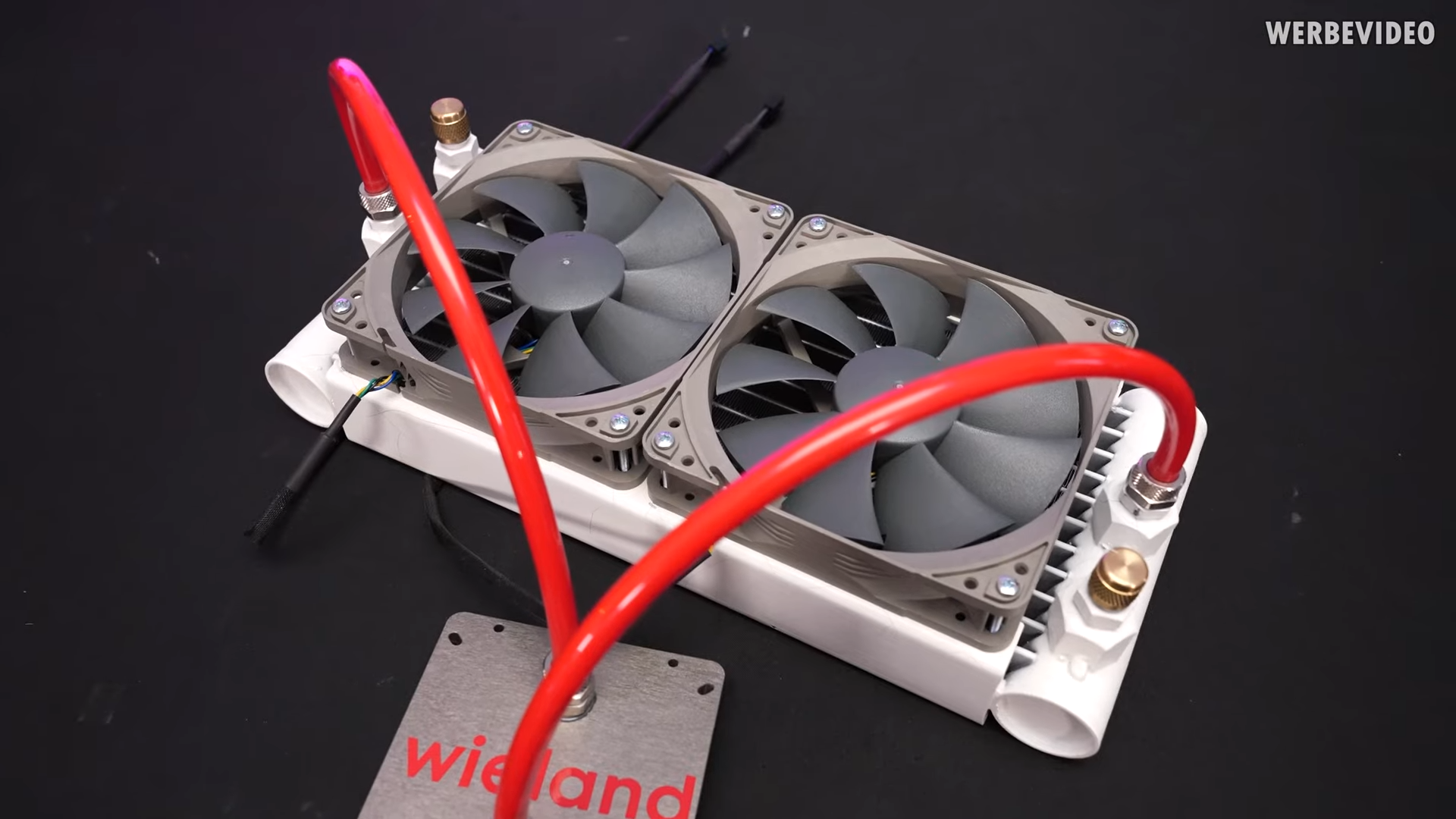
Professional YouTuber and well-respected hardware enthusiast Roman 'Der8auer' Hartung got his hands on a promising prototype CPU cooler that uses thermosyphon technology. A thermosyphon is a method of passive heat exchange based on natural convection, which circulates a fluid without needing a mechanical pump. Wieland, a German-based company with expertise in copper and copper alloy-made cooling products for CPUs, GPUs, and memory, made this quieter alternative to a traditional AiO liquid CPU cooler. Taking the mechanical pump out of the equation lowers operating noise - but cooling performance is reduced somewhat.
At first glance, the prototype Wieland Cold Plate Gaming product looks like it comes with a typical 240mm radiator with two 120mm fans. Things start to appear a little different on closer inspection, as there is a cylindrical housing on either side with tubing connecting to the CPU block. Due to the lack of a pump, the cooling block is not so chunky, and the good thing is that it means there is no pump to generate noise.
The unit De8auer has is a prototype unit. That means the design, color, tubing, and other aspects of the design are not finalized. However, we are getting to see a company a typical PC enthusiast may have never heard of - but has years of expertise. It isn't known what kind of fluid is used inside this closed-loop cooling device. The prototype's aluminum block is milled to be compatible with both AMD's and Intel's contemporary sockets.
Der8auer set up his test system in a Dark Base Pro 901 with an AMD Ryzen 9 7950X CPU running at stock settings on an Asus ROG X670E Hero. Since he was unable to get a factory-supplied 240mm AIO, he taped off one of the 120mm fan mounts on his 360mm Corsair H150i AIO for comparison. With both CPU coolers, he used Kryonaut Extreme thermal compound.
With the Corsair cooler, the system monitor indicated the CPU reached up to 95 degrees Celsius on load when running Cinebench R23 with fans set at 1,600 RPM. Der8auer would subsequently fix the Wieland cooler's fans at this speed for an even comparison


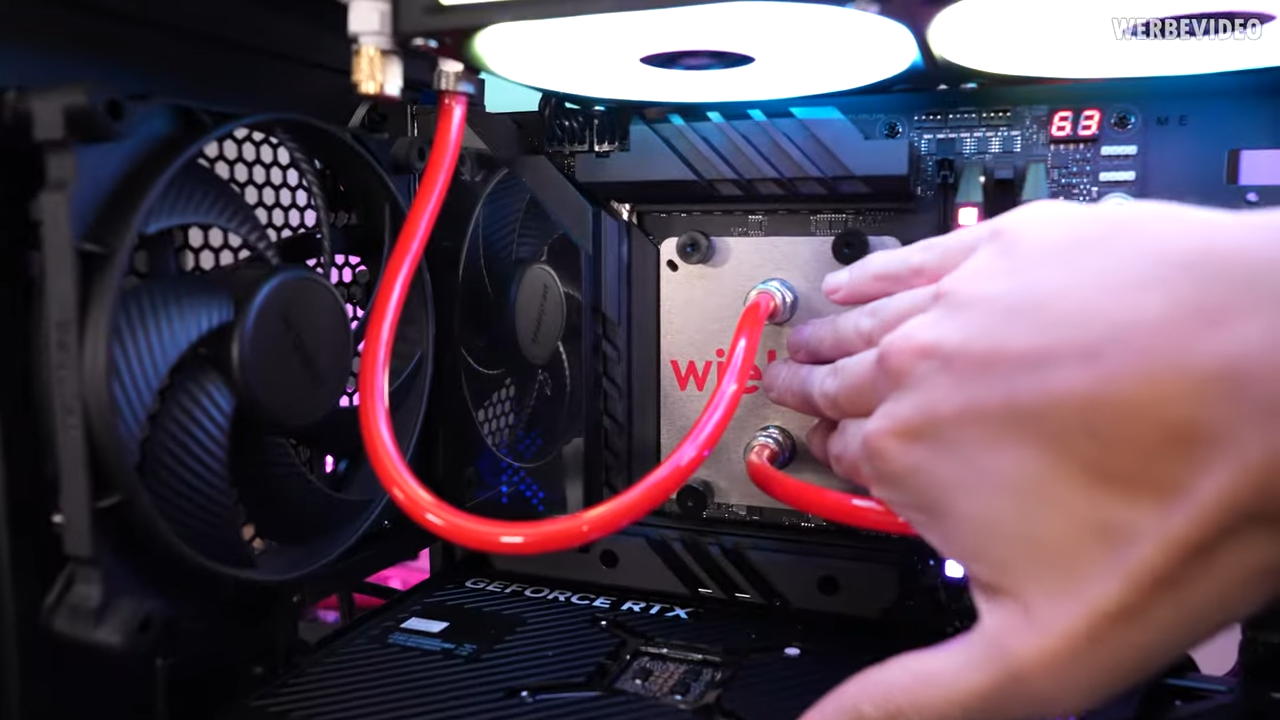
Unlike a typical radiator, the Wieland model needs more space on either (short) side due to cylindrical appendages. The initial observation using the prototype was that the idle temperatures were no different than the typical AIO's equivalent. When gaming benchmarks were run, the cylindrical housing on the right was warmer than the one on the left. With the help of a thermal camera, it can be seen that the CPU block maintains a surface temperature of 54.4 degrees Celsius. You can see in the thermal camera image that both the cylinders are running warmer than the rest of the radiator, with the tube coming from the left side being cooler than the one on the right.
Based on the Cinebench R23 stress test, the AMD Ryzen 9 7950X draws 180 - 185W using the Wieland prototype, but with the Corsair AiO the CPU draws 205W. There's only a little over a 1% performance difference in the Corsair cooled system's favor, which isn't significant.
Get Tom's Hardware's best news and in-depth reviews, straight to your inbox.
| Header Cell - Column 0 | AIO Cooler | Wieland's Prototype |
|---|---|---|
| Gaming | 70C | 77C |
| Cinebench R23 (Single Run) | 95.2C | 95C |
| Multi-Core Score | 36719 pts. | 36272 pts. |
| CPU Package Power Power (Peak) | 223.629 W | 214.925 W |
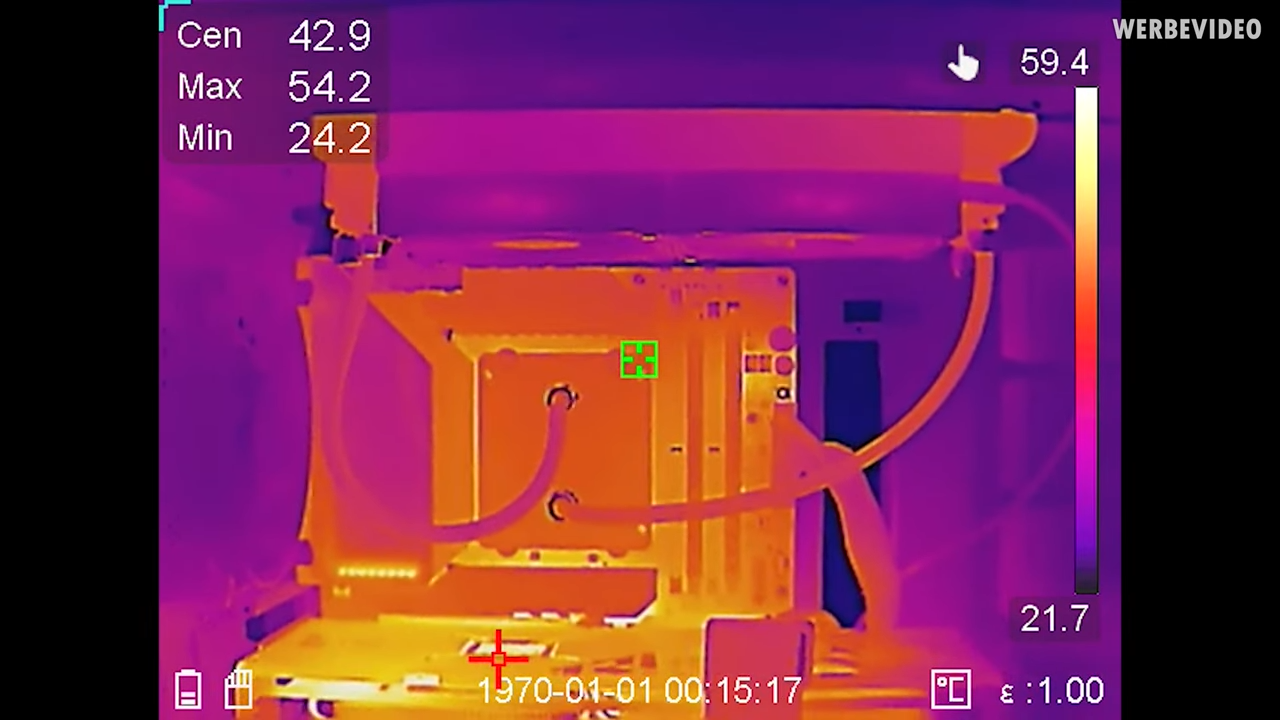
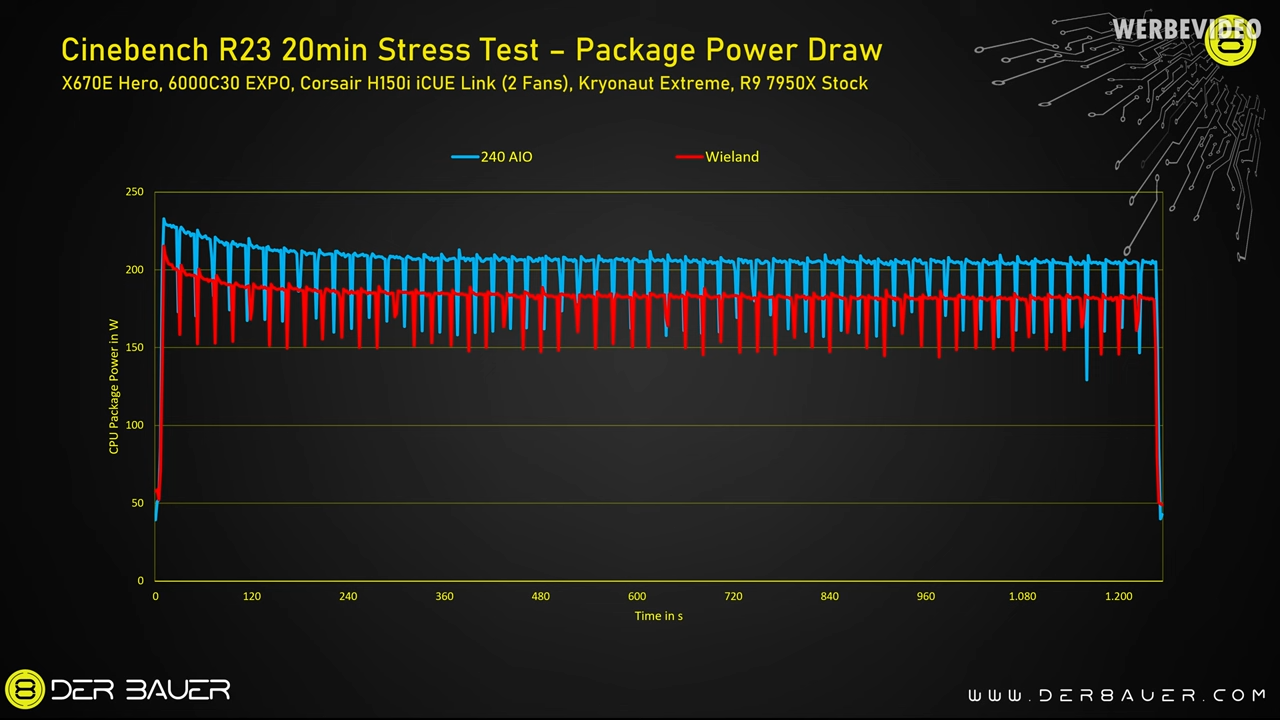
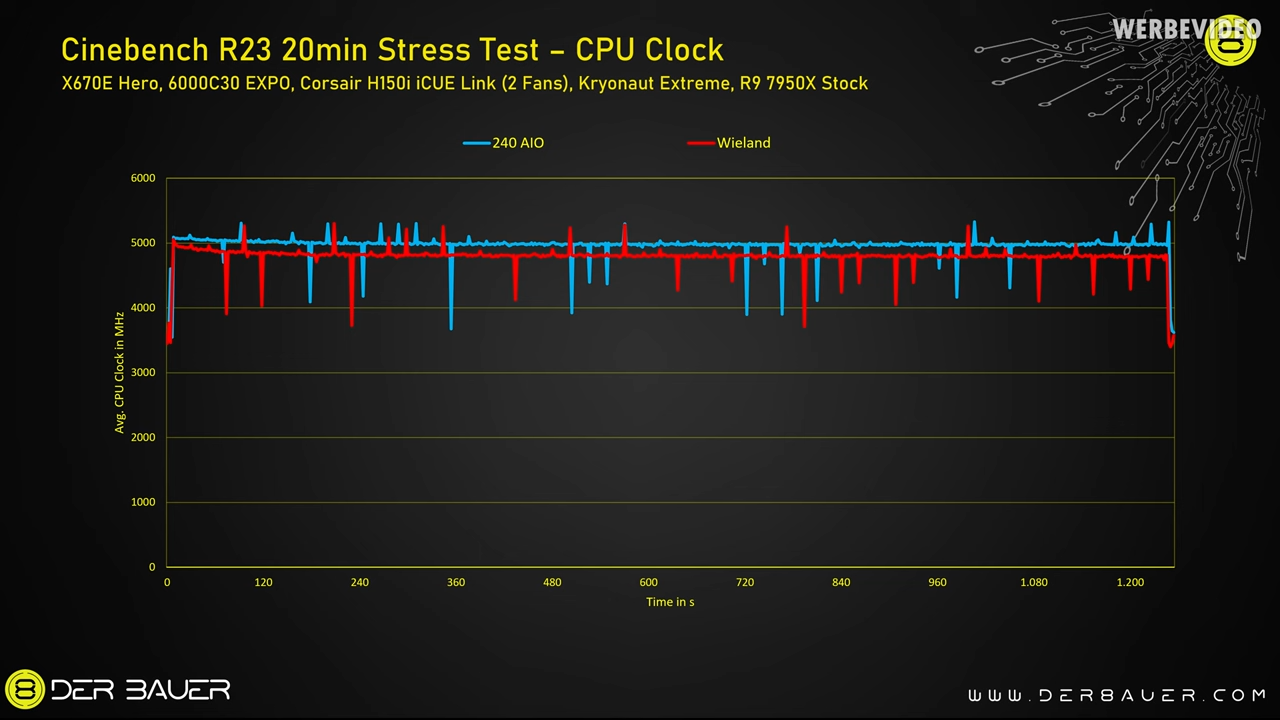
Promising prototype just 8 degrees Celsius behind its pump-powered Corsair rival
There's always room for improvement. Der8auer noticed that the prototype has a large gap between the fan mount and the radiator allowing the fan's air to escape easily. Perhaps some minor design tuning to reduce this gap could pay performance dividends. Der8auer also suggested working on adding more copper to the CPU cooling block. Further research and engineering efforts could bring extra incremental benefits.
As things stand, the CPU cooled by the Wieland AiO operates at about 8 degrees Celsius higher peak temperatures than when using the traditional Corsair AiO. However, the relatively quiet Wieland might be preferred by some, like professionals working in game development and post-production tasks, or those regularly editing music and movies. Another potential benefit of not having a pump is that there is one fewer mechanical component to fail.
It's safe to say that Wieland's liquid cooling looks very promising even in the prototype stage. We also ponder whether the lack of a pump could result in reduced costs, but until products like this are manufactured at scale by multiple companies we would feel foolish to expect such a design to undercut a traditional AiO.
Other companies have tried making thermosyphon technology CPU coolers. Raijintek had a concept six years ago. Der8auer also made a similar cooler which he showcased a few years ago but couldn't be sold as the fluid used was banned by the EU a year after the prototype was made.
As of now, Wieland's Cold Plate Gaming solution seems to be on the right track. Despite needing certain improvements typical of prototypes, it looks promising as a soundless, virtually maintenance-free cooler that could match traditional AIO cooling with enough refinement.

Roshan Ashraf Shaikh has been in the Indian PC hardware community since the early 2000s and has been building PCs, contributing to many Indian tech forums, & blogs. He operated Hardware BBQ for 11 years and wrote news for eTeknix & TweakTown before joining Tom's Hardware team. Besides tech, he is interested in fighting games, movies, anime, and mechanical watches.
-
ezst036 I would like to see this tested fanless, and pair it up with 35w to 65w processors. Or even less than 35w if such processors are available.Reply -
terabite Reply
Is it feasible to use a radiator without fans? I didn't find anything about the matter. I'd suppose you need at least a bit of airflow unless you manage to put it outside the case and use convection.ezst036 said:I would like to see this tested fanless, and pair it up with 35w to 65w processors. Or even less than 35w if such processors are available.
For a 35W processor I suppose a regular tower cooler would be okay -
The Historical Fidelity Taping off one of the fan sections does not make a 360 rad behave like a 240 rad so technically the difference between this thermosyphon and a pumped AIO would be closer still.Reply -
Alvar "Miles" Udell I can't hear any pump noise from my Corsair H150i even set on extreme with all fans off unless my ear is inches away from the block, same with my previous two Corsair liquid coolers, so noise isn't (or shouldn't be) an issue for AIOs, but eliminating the pump does remove one of the only two limiting factors of AIOs, the other being the (very) slow loss of fluid over time.Reply
It will be interesting to see how it scales with smaller 120mm and larger 360mm radiators, and how tolerant of fluid loss over time it is. If it matches or exceeds pump driven AIOs in those respects, it'd be worth paying a slight premium for since there have been multiple issues in the past, and a couple of lawsuits surrounding AIO pumps for patent infringement. -
The Historical Fidelity Reply
I used a cooler master AIO for a gaming build I made for a friend and that pump was so loud I had to turn down the pump speed to make it bearable. I have always used Corsair AIOs in my own builds and I agree with you that I have never noticed noise coming from their pumps.Alvar Miles Udell said:I can't hear any pump noise from my Corsair H150i even set on extreme with all fans off unless my ear is inches away from the block, same with my previous two Corsair liquid coolers, so noise isn't (or shouldn't be) an issue for AIOs, but eliminating the pump does remove one of the only two limiting factors of AIOs, the other being the (very) slow loss of fluid over time.
It will be interesting to see how it scales with smaller 120mm and larger 360mm radiators, and how tolerant of fluid loss over time it is. If it matches or exceeds pump driven AIOs in those respects, it'd be worth paying a slight premium for since there have been multiple issues in the past, and a couple of lawsuits surrounding AIO pumps for patent infringement. -
bit_user As far as I understand it, Thermosyphon technology is essentially a heat pipe that uses a separate return channel. I assume that makes it somewhat orientation-dependent. I wonder if it works better, when mounted vertically.Reply
You can see the radiator is clearly 240 mm. I'm pretty sure text was referring to taping off the extra fan port of the case that would be needed for a 360 mm radiator. I don't know why they even mentioned that part, unless using the mounting position for 360 mm radiators is somehow less advantageous (i.e. more centered over the CPU) than the normal 240 mm position.The Historical Fidelity said:Taping off one of the fan sections does not make a 360 rad behave like a 240 rad -
The Historical Fidelity Reply
According to the article, he used an H150i 360mm AIO to compare temperatures. But I share your question about orientation restrictions, etc. if it is too restrictive, that will destroy its potential market share.bit_user said:As far as I understand it, Thermosyphon technology is essentially a heat pipe that uses a separate return channel. I assume that makes it somewhat orientation-dependent. I wonder if it works better, when mounted vertically.
You can see the radiator is clearly 240 mm. I'm pretty sure text was referring to taping off the extra fan port of the case that would be needed for a 360 mm radiator. I don't know why they even mentioned that part, unless using the mounting position for 360 mm radiators is somehow less advantageous (i.e. more centered over the CPU) than the normal 240 mm position. -
TechLurker I'd like to see this tested against the IceGiant. It's also a thermosiphon, but built into a beefy heatsink that bolts directly over the CPU and is designed to work in two specific orientations; vertical (length-wise) like it'd be in a standard case, and horizontal, like on a testbench. It's also roughly analogous to a 240mm radiator.Reply -
ezst036 Replyterabite said:Is it feasible to use a radiator without fans?
I have no idea, I doubt many people have given it a try. Since this one has some sort of built in motion, it might work. Hopefully a real review would delve into the matter.
Yes, 35w processors work just fine fanless with (some, not all) tower coolers, mostly those coolers on the larger side. My curiosity ran a little more toward the 65w side. -
thestryker Watched the video this morning and couldn't help but wonder if this will become a product. They definitely need to do more work on the coldplate and likely the radiator as I'd imagine having bulges on both sides will lead to potential mounting issues. If they can match the performance of a high end air cooler without the cost being a lot higher I could see the benefit. I'd consider getting one for my 24/7 system where I'd never really consider getting an AIO or using custom liquid cooling.Reply
